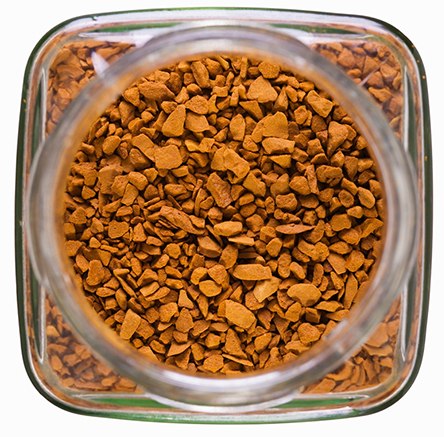Water Determination in Instant Coffee by Karl Fischer Titration
Bettina Straub-Jubb
Foodstuffs include a diverse group of products. Depending on whether carbohydrate-rich, fatty or protein-rich substances are under investigation, different working techniques are preferable. Complex matrices that dissolve slowly in the Karl Fischer solvent, or instances where the water can only be slowly extracted, necessitate the use of a solubilizer. In addition, titration under heating or the use of a homogenizer to accelerate water release are expedient. Coffee represents such a complex matrix.
Coffee is more than just a drink
In the 17th century, coffee was a luxury food and only affordable for the wealthy. However, since the 19th century it has become a mass produced product and a common daily drink for everyone. Additionally, it is now considered an important trading product and also developing into a life style product. Of primary concern to the consumer is that the coffee tastes good. To ensure this, one quality parameter is the water content. The determination of the water in coffee beans, roasted coffee and instant coffee is of interest as it has an influence on the roasting process of the beans and the quality, taste and shelf life of the coffee powder.
Karl Fischer Titration of Instant Coffee
Instant coffee contains firmly bonded water. Its extraction by methanol is slow and sluggish. For volumetric Karl Fischer Titration, the presence of formamide and salicylic acid accelerates the release of water. The salicylic acid has a buffering function to keep the pH in the right range. Additionally, titration under warm conditions, as well as the use of a homogenizer, are favorable. Alternatively, the Karl Fischer oven technique can be used in combination with Coulometry. For the release of water, a temperature of approx. 105 °C is suitable. A direct coulometric titration is not recommended.
Volumetric Karl Fischer Titration procedure
The titration medium is first placed into the cell and titrated dry. As titration medium, 40 mL of Aquastar® CombiMethanol or two component Aquastar® Solvent is filled into the titration cell and 20 mL formamide and 12 g salicylic acid are added. As titrant, Aquastar® CombiTitrant 5 or the two component Aquastar® Titrant 5, if the Aquastar® Solvent is used, can be selected. Then about 0.3 to 0.5 g of the instant coffee sample is added with a weighing boat and the titration is started. The exact sample weight is determined by weighing the boat before and after the sample addition. For a
complete dissolution of the sample, a stirring time of three minutes is recommended. To accelerate the water release, the titration medium can be heated up to 50 °C, using a double wall titration cell connected to a water bath. If the coffee particles are too large, they may need to be crushed before they are added to the titration cell. It is recommended to do a regular titer determination
(e.g. with Aquastar® Water Standard 1%). It is important that the titer determination is done with the
actual titration medium mixture (CombiMethanol or CombiSolvent) containing the formamide and salicylic acid.
Titration instrument parameters:
- Extraction time (stirring time): 180 sec.
- Default titration setting:
I(pol) = 20 - 50 μA, U(EP) = 100 - 250 mV
Stop criterion: drift < 20 μL/min
For a reagents list see Materials.
Karl Fischer Oven Method Procedure combined with Coulometry

A direct coulometric Karl Fischer Titration for instant coffee is not recommended, due to the low water content, the accuracy typically is not sufficient. With the Karl Fischer Oven technique, the water can be extracted/released from the instant coffee sample and be determined in the coulometric titration cell. The Karl Fischer reagent Aquastar® CombiCoulomat frit is suitable for both, the cathode and anode compartment of the titration cell with diaphragm, simplifying the handling/method by needing only one reagent. It is recommended to place about 10 mL of the solution into the cathode and 150 mL into the anode cell. Then the coulometer is started and the solvent is titrated dry. After the pre-titration and stabilization of drift, the series of measurements can be started by determining the blank value for the sample vials. Then 0.1 g sample is weighed into a sample vial, which is immediately tightly capped. The vial is either manually or automatically
placed into the KF oven and heated to the chosen temperature program. The water thereby released is transferred to the titration cell by means of a gas stream (dry air or nitrogen) and coulometrically analyzed. An oven standard (e.g. Aquastar® Oven Standard 1%) is recommended to be ran before the first sample determination, and for longer sample series in between, and at the end of your sample determinations to check/verify the performance of the Karl Fischer oven and titration system throughout the measurements.
The Titration Parameters:
Oven settings:
- Temperature: 105 °C Extraction time: 600 sec
- Default coulometer settings for cell with diaphragm:
End point indication, e.g.:
I(pol) = 5 - 10 μA, U(EP) = 50 - 100 mV
Stop criterion: drift < 20 μg/min
More applications for foodstuffs and beverages can be found at SigmaAldrich.com/application-note.
For individual applications and requests, please contact our application lab.
Explore our Aquastar® portfolio at SigmaAldrich.com/Aquastar
Materials
To continue reading please sign in or create an account.
Don't Have An Account?